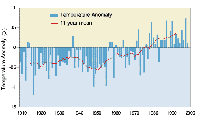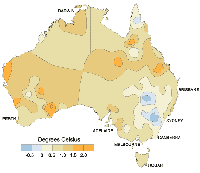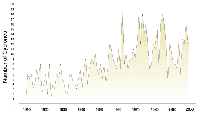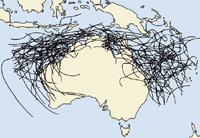


Australian Meteorology through the 20th Century
Introduction
The Origins of Australian Meteorology
Meteorology in the 20th Century
The Weather and Climate of the Twentieth Century
Rainfall
Temperature
Tropical Cyclones
Floods
Droughts
Bushfires
Severe Storms
The Great Weather and Climate Events of the Twentieth Century
A Century of Progress in Science and Service
References
Australian Meteorological Milestones of the 20th Century
Endnotes
Index
Search
Help
Contact us

Temperature
The history of annual mean temperature over Australia through most of the twentieth century is shown in Figure 10.
The overall warming trend during the second half of the century evident in Figure 10 is much more strongly evident in minimum temperatures than in maximum temperatures and it is not uniform over the continent. In fact, some parts of NSW and northern Queensland experienced a slight cooling trend over the century as a whole, as shown in Figure 11.

Tropical Cyclones
Although a number may have gone undetected in the early years and the apparent increase in frequency in the middle part of the century may not be real, it appears that some 800–1,000 tropical cyclones have developed in the Australian region (105–165°E) during the twentieth century, with as few as one and as many as nineteen in a single season (Figure 12). Figure 13 shows their tracks for the ten-year period 1970–80.

The loss of life from tropical cyclones was greatest in the early part of the century, with several infamous cyclones of the early years striking almost without warning. Among the best known are the Broome cyclone of 1908 (loss of 50 lives), the Mackay cyclone of 1918, the Darwin cyclone of 1939, cyclone Ada (which struck the Whitsunday Islands in January 1970 with a loss of 13 lives), cyclone Tracy in 1974 and cyclone Vance (which produced the strongest measured wind gust on mainland Australia (267 km/h) as it passed close to Exmouth, Western Australia, on 22 March 1999).
Floods
The twentieth century witnessed many disastrous floods including both flash floods and riverine floods along the eastern, western and northern coasts as well as in the westward and southwest flowing rivers of the Murray Darling system. Six years: 1954, 55, 56, 59, 71 and 74, stand out as the major flood years of the century, with the Hunter floods of February 1955 and the Brisbane flood of January 1974 perhaps the worst. Other notable floods included the Todd River flood at Alice Springs in March 1910, the Latrobe River flood in Victoria in December 1934, the Charleville flood of April 1990, the northeastern Victorian floods of October 1993 and the Katherine (NT) flood of January 1998.
 |
Bureau of Meteorology |  |
© Online Edition Australian Science and Technology Heritage Centre and Bureau of Meteorology 2001
Published by Australian Science and Technology Heritage Centre, using the Web Academic Resource Publisher
http://www.austehc.unimelb.edu.au/fam/1608.html